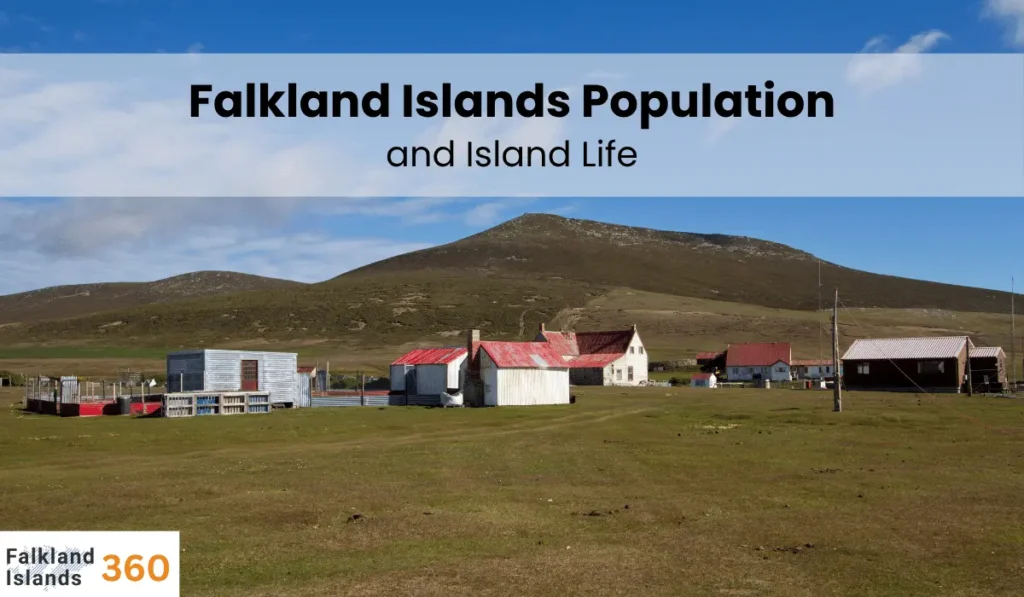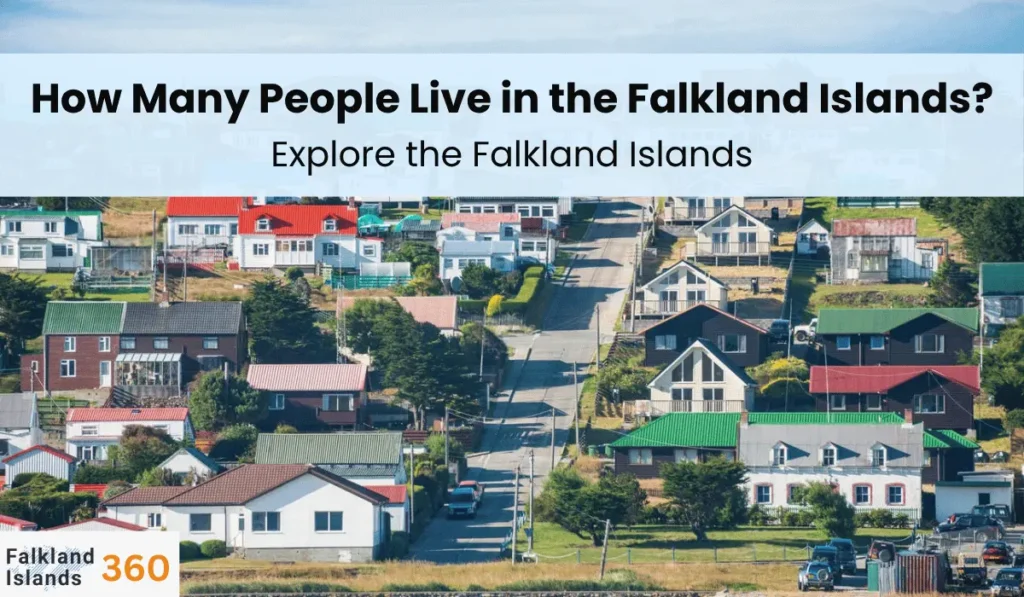The Falkland Islands may be famous for penguins and wind-swept scenery, but only about 3,500 people live here in 2025. Imagine vast landscapes with barely a soul in sight – this is a place where the Falkland Islands population is tiny but tight-knit. Visitors often ask: how many people share this remote archipelago? The answer is just a few thousand, mostly of British heritage, spread across two main islands. In this travel-style guide we’ll explore where they live, what life is like, and why the Falkland Islands population makes for such a special visit.
- Population (2025): ≈3,500 people.
- Main island: East Falkland (capital Stanley) and West Falkland.
- Capital: Stanley (largest town, ~2,000 residents).
- Density: Extremely low, about 0.3 people per km².
- Ethnic mix: Mostly Falkland Islanders (born on the islands) and UK-born residents, plus small St. Helenian (10%) and Chilean (6%) communities.
- Language: English (official); a little Spanish is spoken by migrants and second-generation Falklanders.
- Economy: Sheep farming (wool), fishing and tourism dominate.
The Falkland Islands cover about 12,000 km², but with so few people the Falkland Islands population is one of the world’s sparsest. Official figures show roughly 3,469 residents as of mid-2025. This means huge open spaces between villages. Almost all residents live in and around Stanley on East Falkland, so the rest of the islands (locally called “the Camp”) feel truly wild. Travellers will often drive for hours without passing another car or soul.
Over the decades the Falkland Islands population has climbed gently. In the 1950s it was around 2,200; today’s figure is about 3,500. This growth comes from modest immigration (workers from the UK, Saint Helena and Chile) and from young islanders returning home after studies. In fact, some 85% of Falklanders who go abroad to study eventually come back. Even with more people than half a century ago, life here remains unhurried. You’ll encounter mostly family farms and small fishing crews rather than big cities or traffic.
Settlements: Stanley and the Camp
Stanley – the capital on East Falkland – is home to well over half of the islands’ people. Its waterfront has a few shops, cafes and a visitor centre, and Stanley feels more like a bustling village than a city. The rest of the population is scattered in tiny settlements. Port Louis (an old French landing site) and Goose Green are small villages, each with only a few hundred residents. Most of Camp’s communities are sheep stations and bunkhouses for farm workers.
In many places outside Stanley you’ll find only a few dozen people, a post office, and perhaps a pub or roadhouse. Travel planning here means thinking in terms of days of isolation rather than minutes. Yet locals are warm and welcoming – you might be the only tourist in the room, but you’ll quickly make friends.
Culture and Lifestyle
Life on the Falklands has a unique flavour shaped by isolation. About half of the people consider themselves Falkland Islanders (i.e. born on the islands) and many can trace families back nine generations. Another large group is originally from the UK. There are also traditions from Saint Helena and even Chile woven into daily life. Because falkland islands population is small, everyone pitches in. Unemployment is nearly zero; many islanders hold more than one job. Fishing boats, sheep farms, and tourism businesses keep people busy. Farming is a way of life here: you’ll see vast sheep pastures on both main islands.
Food and festivals are homey and community-led. Islanders bake with locally grown produce (potatoes, vegetables in summer) and serve hearty stews and meat pies. If you visit during a holiday, expect big local gatherings. For example, a Christmas horse race on a grassy plain or the annual “Sports Week” after the shearing season bring everyone together. There are also pubs and clubs where rugby, cricket and shooting leagues play out. In Stanley you can find a small cinema, museums about local history, and even a leisure centre with a pool and gym. Outside town, many activities involve nature – birdwatching, fishing, and hiking – so while the population is low, life is active.
Visiting Tips and Travel Insights
With such a small and spread-out population, travel here feels very different from busy cities. Roads outside Stanley are mostly gravel tracks, and camp (“countryside”) travel often means renting a 4WD or catching a small plane. Ensure you pack layers and waterproofs; the weather can turn quickly on these islands. Petrol stations and shops are few, so plan fuel and supplies carefully. On the plus side, safety is a big bonus – crime is virtually non-existent and travellers report feeling very secure. Locals value politeness and help visitors freely with directions and ferry bookings.
Because of the tiny population, Stanley’s amenities are cozy: a handful of hotels, guest lodges and camp sites. Book ahead during the high season (December–March). Internet and phone coverage is patchy, so download maps and ebooks in advance. Wildlife is everywhere – make time for penguin colonies, seals and albatrosses. Even on popular islands like Carcass or Bleaker, you may see more sheep than people. Learn more about Falkland Islands travel tips here (local tourist board and guidebooks offer practical advice on visas, customs and island etiquette).
Conclusion
The Falkland Islands population is tiny by global standards, but this human thread weaves a warm community through the remote landscape. About 3,500 islanders live here in 2025, mostly in the harbour town of Stanley, yet they form a friendly and resilient society. Visitors will notice how the islands’ British-influenced culture blends with unique local traditions: the neat gardens, sheep stations, and kitchen-table hospitality.
It’s a relaxed pace of life that makes every visit feel like stepping into a different world. For travellers curious about demographics or simply seeking a less-traveled destination, the Falkland Islands offer an extraordinary mix of wilderness and welcoming people. Whether you’re counting sheep or chatting with a Falklander at a pub, you’ll find that this small population has a surprisingly big heart.
FAQs:
What is the current population of the Falkland Islands?
It’s very small – about 3,500 people as of 2025, making these islands one of the world’s least populated.
Where do most Falkland Islanders live?
Nearly 80% of residents live in the capital, Stanley, on East Falkland. The rest are in tiny settlements (called “Camp”) or working on sheep farms.
What is life like in the Falkland Islands?
It’s rural and community-oriented. Most people work in fishing, farming or tourism, and local events (like horse races or pub quizzes) are popular. Daily life revolves around families, sheep stations and enjoying nature.
Are Falkland Islanders friendly?
Yes – with under 3,500 islanders, everyone knows each other. Visitors find locals very welcoming and happy to share stories about island life.
What languages are spoken in the Falklands?
English is the main language. There are also some speakers of Spanish or Afrikaans (especially among immigrants), but you won’t need a translator.
Do I need special travel permits or preparations?
Falklands travel generally requires a valid passport and travel insurance. It’s wise to book accommodations in advance and learn about local rules (for example, don’t use the name “Malvinas” – locals prefer “Falklands”).
How to prepare for weather in the Falklands?
The weather can be unpredictable with quick showers and strong winds. Pack waterproof layers, warm clothing even in summer, and good boots for hikes.


